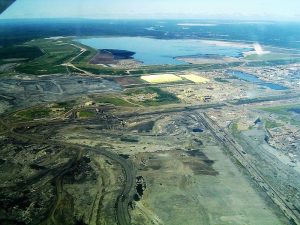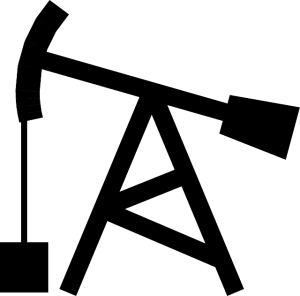WHAT IS HEAVY OIL?
What is Heavy Oil?
Simply defined, heavy oil is liquid petroleum of less than 20° API gravity. It has a high viscosity which keeps it from easily flowing. Its difficult transportation is also due to the lower ratio of hydrogen to carbon as well as the presence of other minerals.
- The main difference between light and heavy oil is the density and hence, its ability to flow.
Heavy oil is asphaltic, dense, and contains very large molecules of sulfur, resins, and metals found within oil, adding to its heavy density. Also, it can sometimes contain waxes and carbon residues which should be removed before refining oil. It is crucial to understand heavy oil’s properties to develop and operate efficient processes to extract oil from the ground.
Canada is one of the leading countries in the production of heavy oil. Therefore, there are different methods implemented across the country for the extraction of heavy oil.
The most common methods are:
- Cold heavy oil production with sand
- Steam assisted gravity drainage
- Steam injection
- Vapor extraction
- Toe-to-Heel air injection
- Open-pit mining
- In-SITU Operations
At Plainsman, we manufacture and distribute products for oilfield production, pipeline maintenance, construction and gas and water distribution. Check our products & services or learn more by calling our experts today 1-877-448-0586
Where does heavy oil come from?
Like most forms of petroleum, heavy oil originated from plant life millions of years ago. Formation of oil occurs when plants and organisms die and decompose. Their sediments are buried and compressed onto the bottom of the sea. Throughout time, weather conditions, the pressure of rocks as well as heat will take the carbohydrates and turn them into hydrocarbons. Then, these reservoirs of oil are most likely found in porous rocks like sandstone and limestone due to these rock’s characteristic permeability.
Canada holds the most extensive areas where oil can be found in the sand and rock commonly referred to as the Oil Sands. Oil sands are a kind of heavy oil and play a big role in our everyday Canadian economy. They contain mixtures of sand, water, and clay known as bitumen.
Heavy Oil Pros and Cons
Currently, heavy oil plays a big role as a large contributor to the world’s energy, specially as new methods for renewable energy are being sought. However, new technologies are looking to replace our existing energy sources. For instance, ethanol, and hydrogen will more easily replace oil, similarly to how oil replaced coal. You can read more about coal and carbon in our blog about the end to Alberta’s carbon taxes by following this link: http://plainsmanmfg.com/blog/albertas-carbon-tax-and-what-it-means-for-you/
Furthermore, Canada’s economy heavily relies on the production of heavy oils, seeing as the region, along with Venezuela, has the largest oil sand reserves in the world.
- Advantage: The energy density that creates an alternative source for transportation fuel and other products like plastics.
- Disadvantage: These processes pose environmental obstacles such as greenhouse gas emissions.
At Plainsman manufacturing we are committed to finding the best ways to produce energy and reduce harmful gas emissions. We deliver superior quality products that meet our customers expectations in a timely, waste-free manner.
What Is Hydraulic Fracturing
‘Unconventional’ Oil & Gas Production
Hydraulic fracturing (also known as ‘fracking’) is the process of pumping a water-based solution down into the ground to fracture the rock within the earth. Fracturing the rock beneath the earth releases valuable compounds that are held within those rocks, such as crude oil and natural gas.
Wells are drilled vertically hundreds to thousands of feet below the earth’s surface, they can then be extended by drilling thousands of feet further horizontally. Once the wells have been drilled, a solution made up of water, proppants such as sand or man-made ceramic materials, and other chemicals are pumped down the wells at a high pressure to blast and fracture the rock below. Proppants are small solid materials such as sand or ceramics that are added to the water-based solution in order to keep induced fractures open after the pressure blasting has finished.
Once the fracturing process has been completed, the solution rises back to the surface along with any other compounds released from the fracturing process due to the internal pressure of the rock beneath the earth. This solution is known as the ‘flowback’, it is then collected and stored so that it can be treated, and the useful Oil and Natural Gas can be separated. The solution is often then recycled and used again for more fracturing.
Hydraulic fracturing is a form of ‘unconventional’ oil and gas production. Until recently, unconventional wells were not economically viable to produce from, since the oil and gas are highly dispersed within the rock instead of being concentrated in one underground location. However, the technological advancements in extraction practices such as hydraulic fracturing have made these wells profitable to produce from, vastly increasing the global supply.
What Are The Canadian Oil Sands

And Their Importance To Canada
Oil sands are a naturally occurring geological phenomenon, made up of a mixture of sand, clay, water, and bitumen. Oil sands can be found in many places around the world, such as Venezuela, the United States, Russia, and of course, Canada.
The Canadian oil sands are located in northeastern Alberta, Canada. Officially called the ‘Athabasca Oil Sands’ they are the worlds largest single deposit of crude bitumen containing roughly 1.7 trillion barrels and contribute to Canada’s total oil reserves, being the third largest in the world after Saudi Arabia, and Venezuela.
They were formed millions of years ago as a result of the formation of the Canadian Rocky Mountains. The Pacific tectonic plate overthrust on the North American tectonic plate, the collision of these two tectonic plates compressed the Albertan plains and raised the Canadian Rockies creating the famous mountain range we know today. As the Albertan plains were compressed by the Pacific plate, sedimentary rock and organic matter were buried deep underground. This created high amounts of pressure and heat underground truing the organic matter into the bitumen found in the oil sands today.
Extraction of the bitumen in the oil sands happens via two main processes. When the bitumen is buried deep within the ground, in-situ extraction is used, which involves using specialized ‘steam-assisted gravity drainage’. In contrast, when the bitumen is located closer to the surface, open pit mining methods are used.
Due to the large reserves of the oil sands in Alberta, the energy industry is extremely important to the province generating revenues of $111.7 billion in 2014.
The Four Main Types Of Crude Oil

What is Crude Oil?
Crude Oil is a liquid found within the earth compromised of hydrocarbons, organic compounds and small amounts of sediments and metal. Within the industry, people talk about ‘Crude Oil’ as if it is just one standard liquid form. However, this is far from the truth.
Crude Oil extracted from the ground in its natural unrefined state varies considerably in its density and consistency, from a very thin and volatile liquid to an extremely thick, semi-solid heavy weight oil. Furthermore, the colour of Crude Oil extracted from the ground can range substantially, from a light golden yellow to a deep dark black.
As we have now established, ‘Crude Oil’ is a term used to describe many different types of raw oil extracted from the ground. Within the industry, we categorize these different types into four main categories based on three factors: their viscosity, volatility, and toxicity.
Viscosity refers to the oils ability to flow. Higher viscosity oils do not flow as easily and therefore take more energy and effort to pump from the ground.
Volatility describes how quickly and easily the oil evaporates into the air. Higher volatility oils need additional processes to control their environments during extraction to ensure that as little oil as possible is lost.
Toxicity refers to how poisonous and harmful the oil is to the environment, wildlife, and humans during the extraction and refinement process. When oil spills do occasionally occur, each oil poses different challenges and priorities during the cleanup.
With that said, the four main types of Crude Oil are:
- Very light oils – these include: Jet Fuel, Gasoline, Kerosene, Petroleum Ether, Petroleum Spirit, and Petroleum Naphtha. They tend to be very volatile, evaporating within a few days which in turn evaporates their toxicity levels.
- Light oils – These include Grade 1 and Grade 2 Fuel Oils, Diesel Fuel Oils as well as Most Domestic Fuel Oils. They are both moderately volatile and toxic.
- Medium oils – These are the most common types of Crude Oil. They generally have low volatility and a higher viscosity than the light oils which leads to higher toxicity and a greater environmental impact during cleanups.
- Heavy fuel oils – These include the heaviest Grade 3,4,5 and 6 Fuel Oils along with Heavy Marine Fuels. These are the most viscous and least volatile Crude Oils as well as the most toxic.
The Difference Between Crude Oil & Natural Gas
And What They’re Used For
 Crude Oil and Natural Gas are both fossil fuels formed from the remains of dead animal and plants over the course of thousands of years. They both are used as a heat source, produce energy, and are both made up of different hydrocarbons which are compounds of both hydrogen and carbon.
Crude Oil and Natural Gas are both fossil fuels formed from the remains of dead animal and plants over the course of thousands of years. They both are used as a heat source, produce energy, and are both made up of different hydrocarbons which are compounds of both hydrogen and carbon.
So, what’s the difference between them?
The biggest difference between Crude Oil and Natural Gas is their molecular makeup.
Crude Oil is comprised of a wide and diverse selection of complex hydrocarbons. Because of its unique and complex makeup, Crude Oil comes in many different forms and its viscosity and volatility can vary widely. Due to each deposit of Crude Oil having its own unique mix of chemicals, it requires extensive refining for it to be commercially used.
Natural Gas is also made up of a mixture of different hydrocarbons, such as gasses like ethane, propane, butane, and pentane. However, the greatest benefit of natural gas is that its main component (roughly 80%) is the relatively simple hydrocarbon methane. This simple structure makes natural gas much easier to refine for commercial use.
Finally, they differ in their uses and consumption.
After refinement Crude Oil is generally used for the following:
- Gasoline
- Heating Oil & Diesel Fuels
- Other Products (such as plastics)
- Jet Fuel
- Propane
- Residential Fuel Oil
- Asphalt
Whereas Natural Gas is used for:
- Electrical Power Generation
- Residential Heating
- Commercial Heating
- Industrial Production

